2015 TOYOTA TACOMA oil temperature
[x] Cancel search: oil temperaturePage 402 of 590

402 4-3. Do-it-yourself maintenance
CAUTION
The engine compartment contains many mechanisms and fluids that may
move suddenly, become hot, or become electrically energized. To avoid death
or serious injury observe the following precautions.
■When working on the engine compartment
●Keep hands, clothing, and tools away from the moving fan and engine
drive belt.
● Be careful not to touch the engine, radiator, exhaust manifold, etc. right
after driving as they may be hot. Oil and other fluids may also be hot.
● Do not leave anything that may burn easily, such as paper or rags, in the
engine compartment.
● Do not smoke, cause sparks or expose an open flame to fuel or the bat-
tery. Fuel and battery fumes are flammable.
● Be extremely cautious when working on the battery. It contains poisonous
and corrosive sulfuric acid.
● Take care because brake fluid can harm your hands or eyes and damage
painted surfaces.
If fluid gets on your hands or in your eyes, flush the affected area with
clean water immediately.
If you still experience discomfort, see a doctor.
■ When working near the cooling fan or radiator grille
Be sure the engine switch is off.
With the engine switch on, the cooling fan may automatically start to run if
the air conditioning is on and/or the coolant temperature is high.
■ Safety glasses
Wear safety glasses to prevent flying or falling material, fluid spray, etc. from
getting in the eyes.
Page 408 of 590
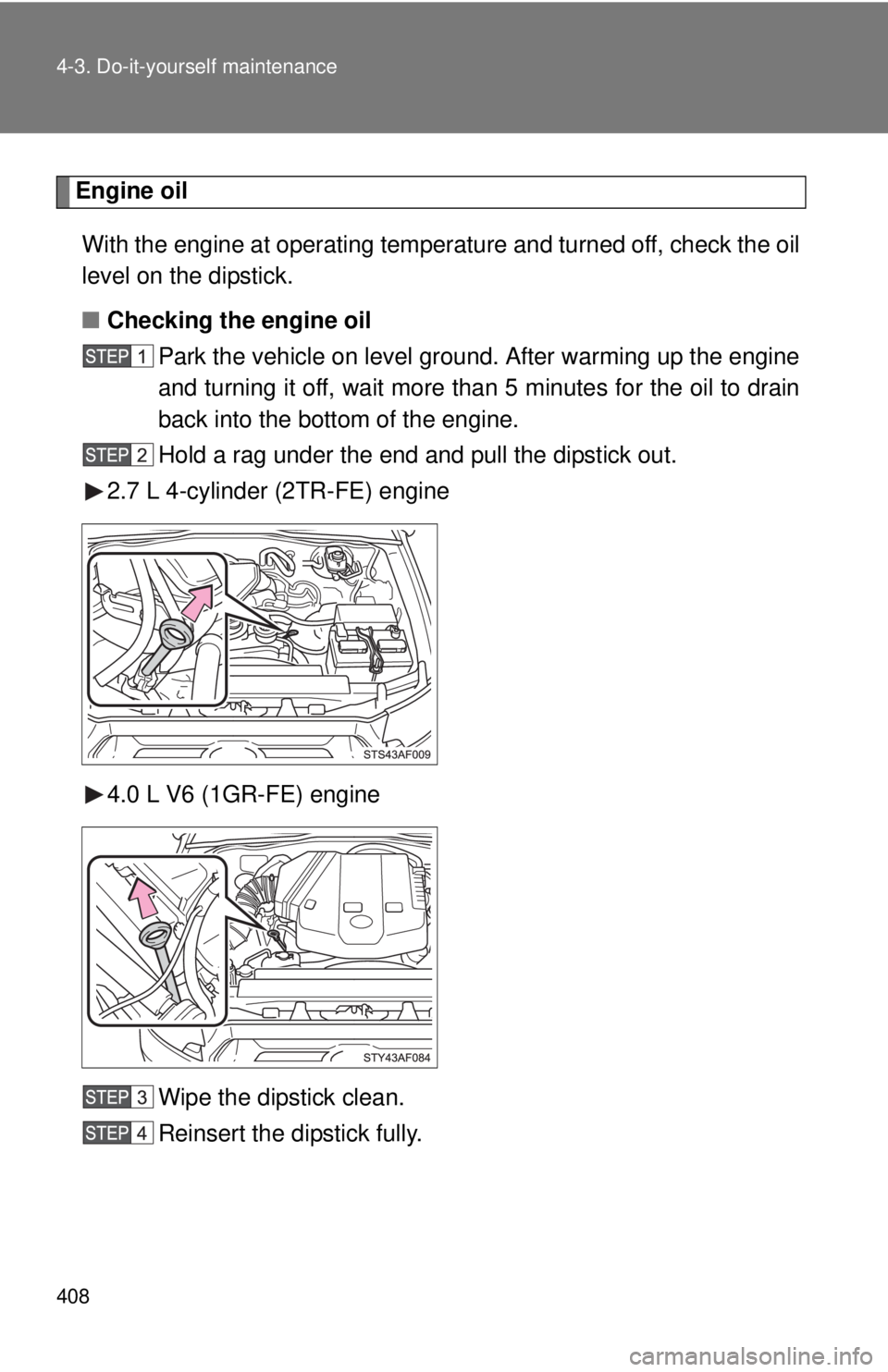
408 4-3. Do-it-yourself maintenance
Engine oil
Engine oilWith the engine at operating temperature and turned off, check the oil
level on the dipstick.
■ Checking the engine oil
Park the vehicle on level ground. After warming up the engine
and turning it off, wait more than 5 minutes for the oil to drain
back into the bottom of the engine.
Hold a rag under the end and pull the dipstick out.
2.7 L 4-cylinder (2TR-FE) engine
4.0 L V6 (1GR-FE) engine
Wipe the dipstick clean.
Reinsert the dipstick fully.
Page 527 of 590
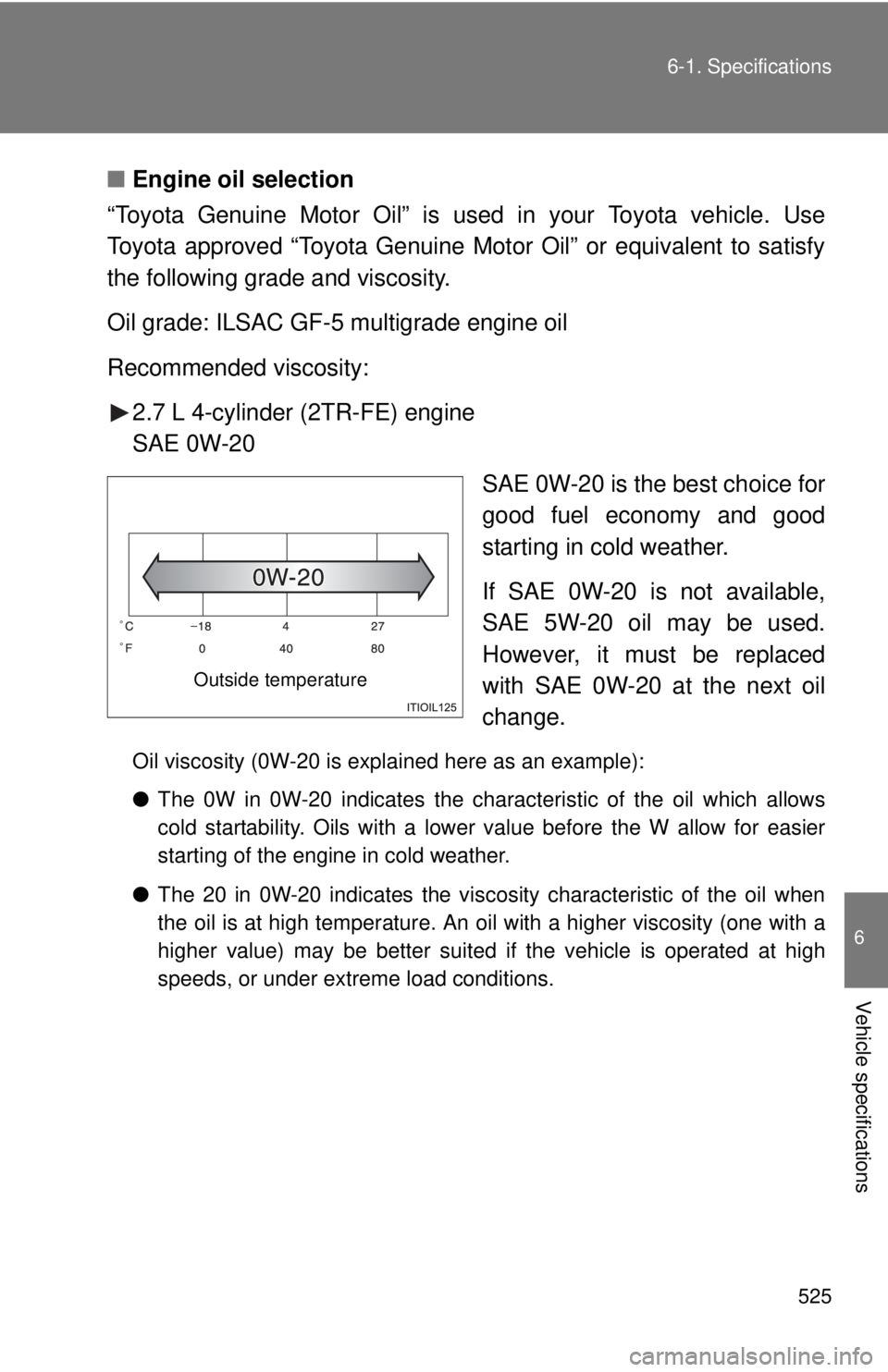
525
6-1. Specifications
6
Vehicle specifications
■
Engine oil selection
“Toyota Genuine Motor Oil” is used in your Toyota vehicle. Use
Toyota approved “Toyota Genuine Motor Oil” or equivalent to satisfy
the following grade and viscosity.
Oil grade: ILSAC GF-5 multigrade engine oil
Recommended viscosity:
2.7 L 4-cylinder (2TR-FE) engine
SAE 0W-20 SAE 0W-20 is the best choice for
good fuel economy and good
starting in cold weather.
If SAE 0W-20 is not available,
SAE 5W-20 oil may be used.
However, it must be replaced
with SAE 0W-20 at the next oil
change.
Oil viscosity (0W-20 is explained here as an example):
●The 0W in 0W-20 indicates the characteristic of the oil which allows
cold startability. Oils with a lower value before the W allow for easier
starting of the engine in cold weather.
● The 20 in 0W-20 indicates the viscosity characteristic of the oil when
the oil is at high temperature. An oil with a higher viscosity (one with a
higher value) may be better suited if the vehicle is operated at high
speeds, or under extreme load conditions.
Outside temperature
Page 528 of 590
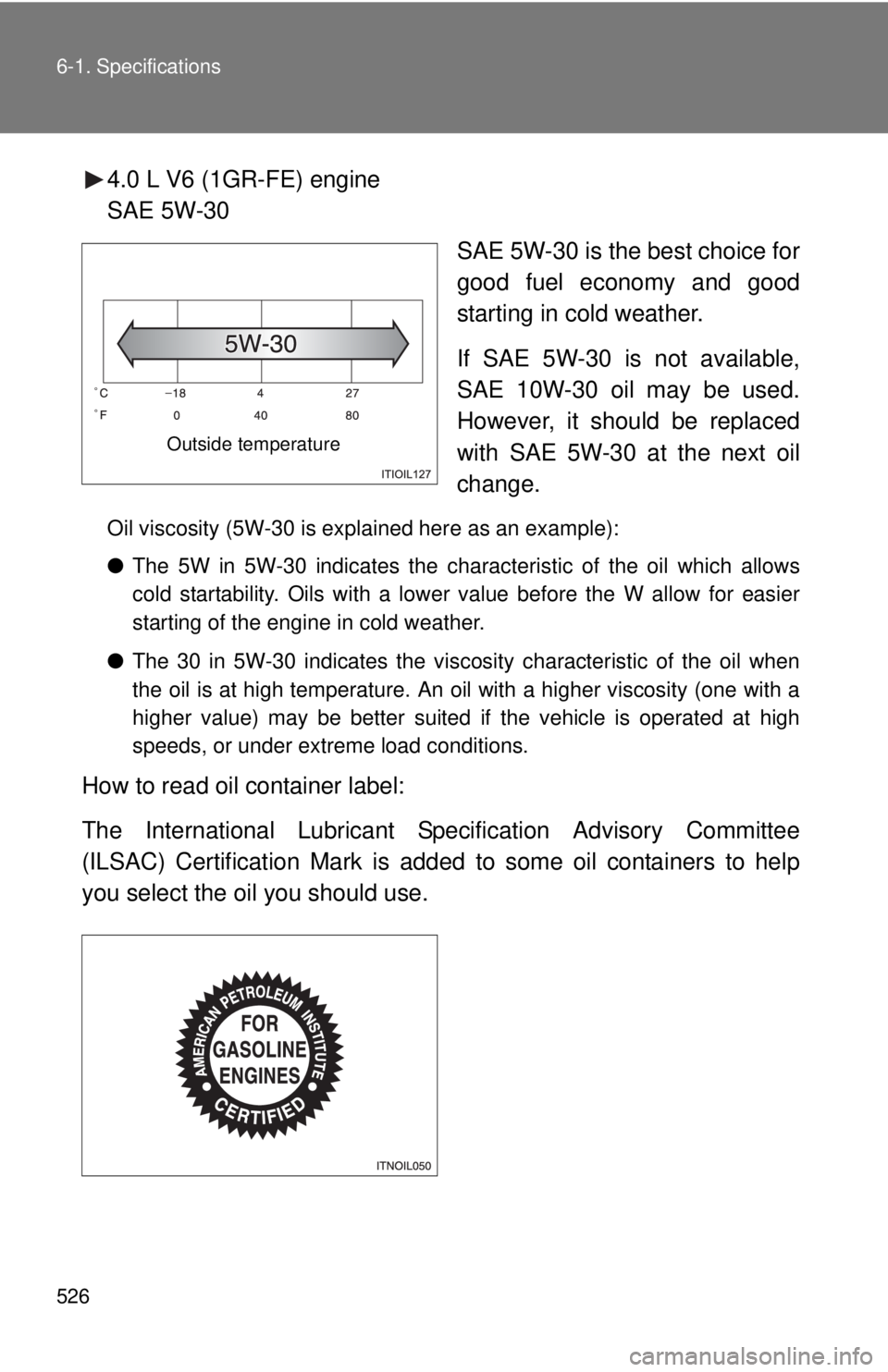
526 6-1. Specifications
4.0 L V6 (1GR-FE) engine
SAE 5W-30SAE 5W-30 is the best choice for
good fuel economy and good
starting in cold weather.
If SAE 5W-30 is not available,
SAE 10W-30 oil may be used.
However, it should be replaced
with SAE 5W-30 at the next oil
change.
Oil viscosity (5W-30 is explained here as an example):
●The 5W in 5W-30 indicates the characteristic of the oil which allows
cold startability. Oils with a lower value before the W allow for easier
starting of the engine in cold weather.
● The 30 in 5W-30 indicates the viscosity characteristic of the oil when
the oil is at high temperature. An oil with a higher viscosity (one with a
higher value) may be better suited if the vehicle is operated at high
speeds, or under extreme load conditions.
How to read oil container label:
The International Lubricant Spec ification Advisory Committee
(ILSAC) Certification Mark is added to some oil containers to help
you select the oil you should use.
Outside temperature
Page 547 of 590
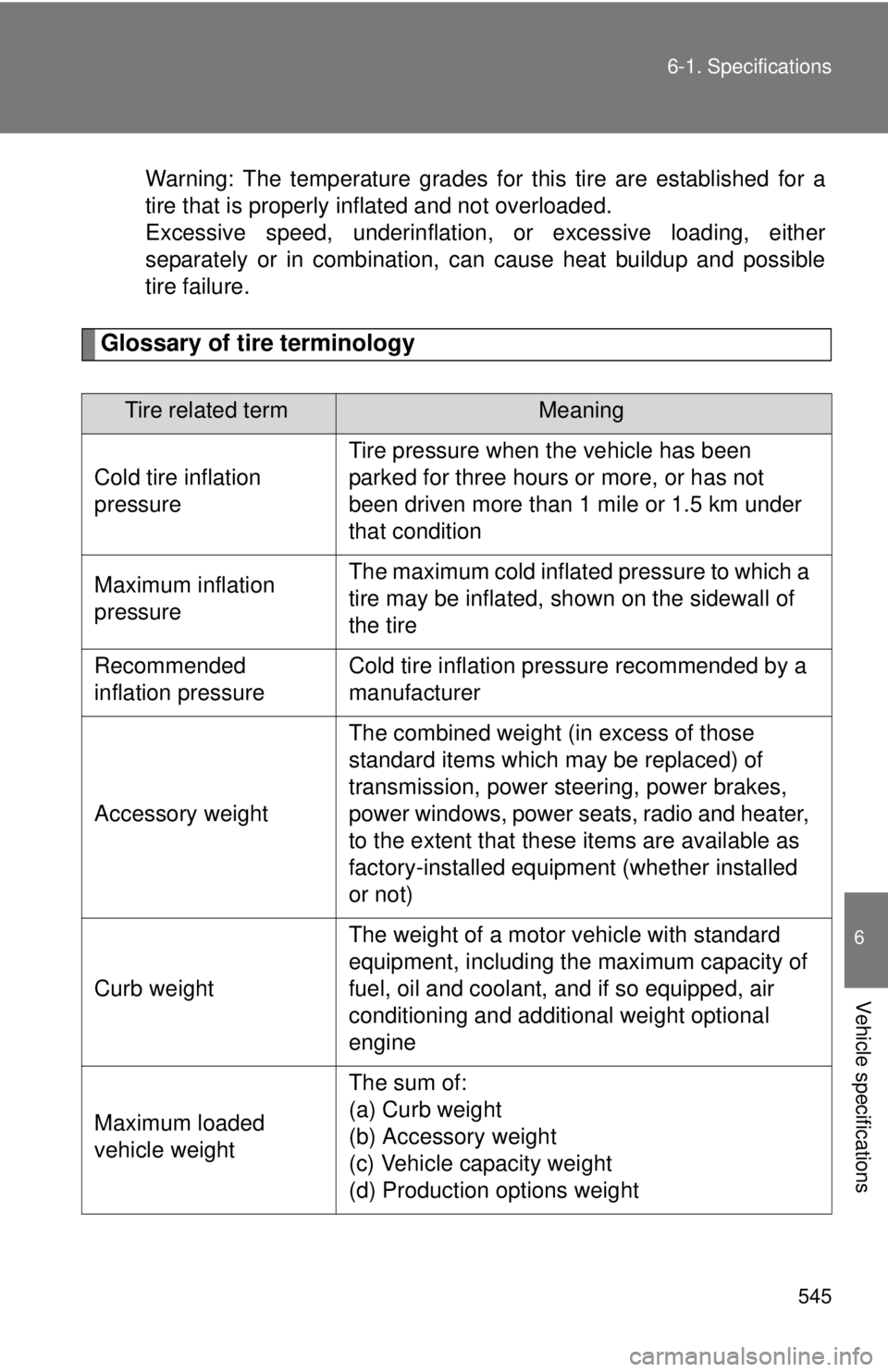
545
6-1. Specifications
6
Vehicle specifications
Warning: The temperature grades for this tire are established for a
tire that is properly inflated and not overloaded.
Excessive speed, underinflation,
or excessive loading, either
separately or in combination, can cause heat buildup and possible
tire failure.
Glossary of tire terminology
Tire related termMeaning
Cold tire inflation
pressure
Tire pressure when the vehicle has been
parked for three hours or more, or has not
been driven more than 1 mile or 1.5 km under
that condition
Maximum inflation
pressureThe maximum cold inflated pressure to which a
tire may be inflated, s hown on the sidewall of
the tire
Recommended
inflation pressureCold tire inflation pressure recommended by a
manufacturer
Accessory weight
The combined weight (in excess of those
standard items which may be replaced) of
transmission, power steering, power brakes,
power windows, power seats, radio and heater,
to the extent that these items are available as
factory-installed equipment (whether installed
or not)
Curb weight
The weight of a motor vehicle with standard
equipment, including the maximum capacity of
fuel, oil and coolant, and if so equipped, air
conditioning and additional weight optional
engine
Maximum loaded
vehicle weight
The sum of:
(a) Curb weight
(b) Accessory weight
(c) Vehicle capacity weight
(d) Production options weight
Page 580 of 590

578 Alphabetical index
Daytime running light system .................................... 154
Deck Auxiliary boxes ...................... 365
Deck ...................................... 364
Deck hooks ........................... 366
Deck rails .............................. 202
Tie-down cleats ..................... 367
Detachable pole antenna......... 335
Dimension................................. 516
Dinghy towing .......................... 233
Do-it-yourself main tenance..... 400
Doors Access doors...........................39
Door glasses ...........................71
Door lock ...........................32, 35
Open door warning light ........ 479
Side doors ...............................35
Side mirrors .............................68
Downhill Assist Control
System .................................... 188
Driver’s seat belt reminder light ......................................... 479
Driver’s seat belt reminder warning buzzer ...................... 479
Driving
Break-in tips .......................... 122
Correct posture .......................80
Driving assist systems........... 191
Procedures ............................ 120
Winter driving tips.................. 209
Emergency, in case of Blown fuse............................. 444
If the engine will not start ...... 501
If the shift lever cannot be shifted from P...................... 502
If the vehicle battery is discharged .......................... 504
If the warning buzzer
sounds ................................ 476
If the warning light turns on ... 476 If you have a flat tire ............. 486
If you lose your keys ............. 503
If you think something is
wrong .................................. 474
If the vehicle becomes
stuck ................................... 511
If your vehicle has to be stopped in an emergency ... 513
If your vehicle needs to be towed .................................. 467
If your vehicle overheats ....... 508
Emergency flashers Switch ................................... 466
Engine
Compartment ........................ 406
Engine switch ........................ 131
Exhaust gas .......................... 127
Hood ..................................... 404
How to start the engine ......... 131
Identification number............. 521
If the engine will not start ...... 501
Ignition switch ....................... 131
Immobilizer system ................. 77
Overheating .......................... 508
Warning light ......................... 477
Engine coolant
Capacity ................................ 527
Checking ............................... 412
Preparing and checking before winter ....................... 209
Temperature gauge .............. 145
Engine coolan t temperature
gauge ...................................... 145
Engine immobilizer system ...... 77
Engine oil Capacity ................................ 524
Checking ............................... 408
Preparing and checking before winter ....................... 209
Warning light ......................... 477
Engine switch........................... 131
Event data recorder ................... 24D
E
Page 586 of 590

584 Alphabetical index
Vanity mirrors........................... 350
Vehicle control and operation data recording ........23
Vehicle data recordings ............23
Vehicle identification number ................................... 521
Vehicle stability control........... 191
VSC............................................ 191
Warning buzzers Key reminder ......................... 482
Brake system ........................ 476
Seat belt reminder ................. 479
Warning lights ABS ....................................... 477
Airbag system ....................... 477
Anti-lock brake system .......... 477
Automatic transmission fluid temperature ................. 479
Brake system ........................ 476
Charging system .... ............... 477
Driver’s seat belt ................... 479
Electronic engine control
system ................................ 477
Engine oil replacement.......... 479
Front passenger occupant
classification system ........... 477
Front passenger’s seat
belt ...................................... 479
Low brake fluid ...................... 476
Low engine oil pressure ........ 477
Low fuel level ........................ 479
Low tire inflation pressure ..... 479
Malfunction indicator lamp .... 477
Open door ............................. 479
Seat belt ................................ 479
Seat belt pretensioner system ................................ 477
SRS ....................................... 477
SRS airbag system ............... 477 Tire pressure ......................... 479
Tire pressure warning
system ................................ 479
VSC/TRAC ............................ 477
Washer
Checking ............................... 420
Preparing and checking before winter ....................... 209
Switch ................................... 156
Washing and waxing ............... 388
Weight Cargo capacity ...................... 202
Cargo weight rating ............... 568
Gross axle weight rating ....... 570
Gross combination weight rating................................... 218
Gross vehicle weight
rating................................... 570
Load limits ............................. 207
Trailer weight rating ...... 218, 519
Vehicle capacity weight......... 518
Weight ................................... 518
Wheels ...................................... 436
Window glasses ................. 71, 73
Window lock switch................... 71
Windows
Power windows ....................... 71
Washer.................................. 156
Windshield wipers ................... 156
Wireless remote control
Replacing the battery ............ 442
Wireless remote control .......... 32
Winter driving tips ................... 209
WMA disc.................................. 263V
W
Page 589 of 590
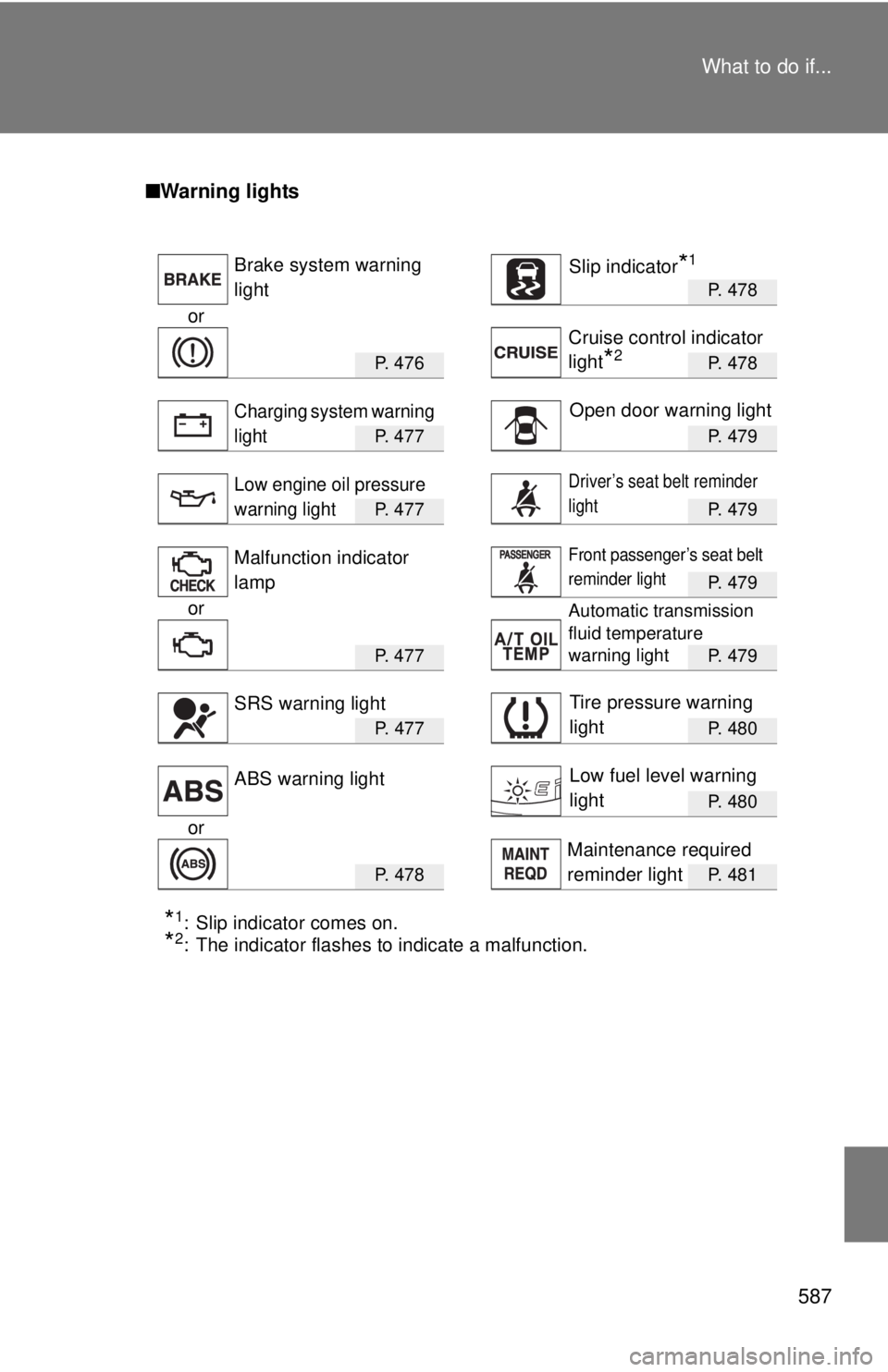
587
What to do if...
■
Warning lights
P. 478
or
P. 476 P. 478
P. 477 P. 479
P. 477 P. 479
P. 479
or
P. 477 P. 479
P. 4 7 7P. 480
P. 480
or
P. 4 7 8P. 481
*1: Slip indicator comes on.*2: The indicator flashes to indicate a malfunction.
Brake system warning
lightSlip indicator*1
Charging system warning
lightOpen door warning light
Low engine oil pressure
warning lightDriver’s seat belt reminder
light
Malfunction indicator
lampFront passenger’s seat belt
reminder light
SRS warning lightTire pressure warning
light
ABS warning lightLow fuel level warning
light
Maintenance required
reminder light
Automatic transmission
fluid temperature
warning light
Cruise control indicator
light
*2